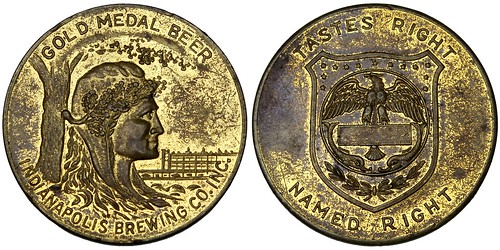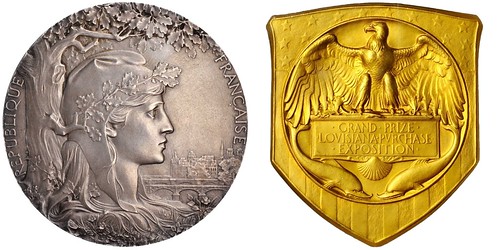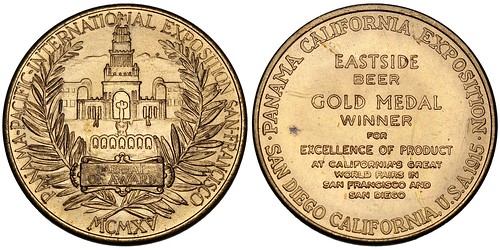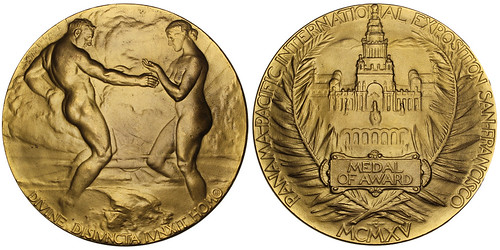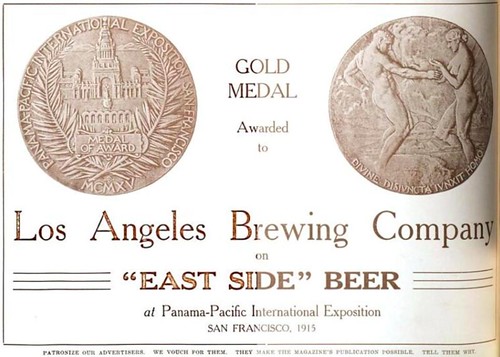
PREV ARTICLE
NEXT ARTICLE
FULL ISSUE
PREV FULL ISSUE
V25 2022 INDEX E-SYLUM ARCHIVE MEDALLIC ART AS ADVERTISING IN BREWINGJeremy Bostwick submitted this interesting article about brewing medals and their artistic influences. Thanks! Interesting connections! -Editor
Medallic Art as Advertising in Brewing
In the world of brewing, there is no higher achievement domestically than receiving a medal, especially a first place (gold) medal, in the Great American Beer Festival—an event held annually since 1982 in Denver, Colorado. Despite being American, it nevertheless holds great weight internationally, as the United States has been at the forefront of innovations and inventiveness in craft brewing over the past three decades or so. In a way, more specialized, industry-specific trade shows such as this have taken on the role once filled by international expositions in the earlier part of the 20th or even 19th centuries. Though they still exist, the hype generated from a winning entry at a world's fair was immense in the days of yesteryear, with many companies boasting greatly about their prior win(s), even to the point of adding such a prize to their name and/or advertising. This concept brings forth two such pieces of exonumia that caught my eye. I have a great interest in medallic art and the many medals associated with numerous world's fairs, while also being an aficionado of craft beers and the history of brewing. In the case of the first medal, that of the Indianapolis Brewing Company, one immediately recognizes not just one, but two familiar designs… (first image—from the author's collection; the second—a composite courtesy of Stack's Bowers Galleries) The obverse is a direct copy from the obverse of the official 1900 expo held in Paris and designed by one of the Art Nouveau masters, Jules-Clément Chaplain. Meanwhile, the reverse design clearly channels that of the various official award medals issued just four years later at the next world's fair—that of the Louisiana Purchase expo held in St. Louis, Missouri in 1904. Not only that, the distinctive shape of the design circumscribed within the round shape of the medal conveys that of the grand prize handed out at the aforementioned expo.
So, what to make of this interesting pairing? You'll note that the medal in the first image lacks a date or any other reference to place it. However, a bit of research reveals that the Indianapolis Brewing Company (formed in 1889 after the merger of the Schmidt, Lieber, and Maus Breweries) entered their Dusseldorfer beer into the Paris expo in 1900. For this entrant, the brewery won a gold medal, hence the name which brew thus earned—that of
Clearly, this piece of exonumia was meant to promote the accolades received by the brewery for their prized beer, though only someone familiar with the designs of the expo medals themselves, especially many decades removed from such events, would even begin to draw the immediate connection. It's difficult to know if Chaplain or Adolph A. Weinman—famous for the design of the Fast-forwarding just a decade, one undoubtedly recognizes yet another expo medal that was mimicked for the purposes of brewery advertising… (the first image—from the author's collection; the second—from the author's past inventory) A "Los Angeles Times" article from 1997 paints the celebrated picture of the Los Angeles Brewery on the centennial of the brewery's founding in 1897. Ten years later, German-born George Zobelein, already well-established within the brewing industry in L.A., ventured out on his own and acquired the brewery. In the 1915 Panama-Pacific expo, Zobelein and his brewery earned a gold medal for "East Side" (sometimes rendered as "Eastside") beer. As mentioned in the article,"...ambitious from the start, Zobelein combined his own recipes with state-of-the-art technology to brew a line of beers, including a pilsener called Eastside, Old Mission Malt, a potent bock and, later, Old Tap Lager." It is very probable that it was this first beer, the pilsener, that garnered the award. So popular was the brew that the Los Angeles Brewery would also go by the name "Eastside Brewery," given the well-known status of the beer. Similar to the promotional medal issued by the Indianapolis Brewing Company mentioned earlier, the Los Angeles Brewery also sampled the official award medal that it earned, though the latter certainly filled in the details that much better than the former. This medal retains the reverse of the official medal designed by John Flanagan (famous for the Washington quarter), with the familiar façade of the Tower of Jewels prominently reproduced as the focal point, and with the legends following suit as well. Meanwhile, the reverse is a departure, utilizing the space instead to convey more information recounting the award for "excellence of product." Further attesting to the pride exuded for the earning of such a medal, an image of the award itself, reverse and obverse, was used in an advertisement by the brewery in a California-based periodical just a few months after the conclusion of the expo in March 1916... (advertisement in the March 1916 issue of "The Grizzly Bear") Though the brewery was later acquired by Pabst Blue Ribbon in 1948 and eventually closed down in 1979, the location nevertheless remains a hub of creativity, now in the form of artist lofts known as "The Brewery." Furthermore, not too far from where Eastside and other beers were brewed by Zobelein, Angel City Brewery has begun to honor that tradition with their "Eastside Series" of beers, "...celebrating L.A.'s brewing heritage" and "...paying homage to the classic beer styles of the early 20th century." Ultimately, one of the greatest aspects of the fairly expansive world of medals is the stumbling upon nuggets such as these—recognizing what may be, at first glance, rather innocuous iconographic representations, and then making the connection to something more specific within exonumia. No matter what pastimes or leisurely pursuits one may have outside of numismatics, there likely exists a connection to it within numismatics, allowing for the blending of the two and making collecting that much more specific—and rewarding—to the individual collector.
For more information:
Wayne Homren, Editor The Numismatic Bibliomania Society is a non-profit organization promoting numismatic literature. See our web site at coinbooks.org. To submit items for publication in The E-Sylum, write to the Editor at this address: whomren@gmail.com To subscribe go to: https://my.binhost.com/lists/listinfo/esylum All Rights Reserved. NBS Home Page Contact the NBS webmaster 
|
